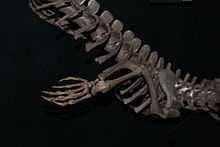Alligatoridae
| Alligatorids Temporal range: Late Cretaceous - Recent,[1] 83–0Ma | |
|---|---|
 | |
| American Alligator Alligator mississippiensis | |
| Scientific classification | |
| Kingdom: | Animalia |
| Phylum: | Chordata |
| Class: | Reptilia |
| Superorder: | Crocodylomorpha |
| Order: | Crocodilia |
| Clade: | Globidonta |
| Family: | Alligatoridae Gray, 1844 |
| Subfamilies | |
| |
The Alligatoridae family of crocodylians includes alligators and caimans.
True alligators
The lineage including alligators proper (Alligatorinae) occurs in the fluvial deposits of the age of the Upper Chalk in Europe, where they did not die out until the Pliocene age. The true alligators are today represented by two species, A. mississippiensis in the southeastern United States, which can grow to 14 ft (4.24 m) and weigh 1000 lbs (455 kg)[2] and the small A. sinensis in the Yangtze River, China, which grows to an average of 5 ft (1.5 m). Their name derives from the Spanish el lagarto, which means "the lizard".
Caimans
In Central and South America, the alligator family is represented by five species of the genus Caiman, which differs from the alligator by the absence of a bony septum between the nostrils, and the ventral armour is composed of overlapping bony scutes, each of which is formed of two parts united by a suture. Some authorities further divide this genus into three, splitting off the smooth-fronted caimans into a genus Paleosuchus and the black caiman into Melanosuchus. Caimans tend to be more agile and crocodile-like in their movements, and have longer, sharper teeth than alligators.[3]
C. crocodilus, the spectacled caiman, has the widest distribution, from southern Mexico to the northern half of Argentina, and grows to a modest size of about 2.2 m (7 ft). The largest is the near-threatened Melanosuchus niger, the jacare-assu or large or black caiman of the Amazon River basin. Black caimans grow to 16.5 ft (5 m),[4] with the largest recorded size 5.79 m (19 ft). The black caiman and American alligator are the only members of the alligator family that pose the same danger to humans as the larger species of the crocodile family.
Although caiman have not been studied in-depth, scientists have learned their mating cycles (previously thought to be spontaneous or year-round) are linked to the rainfall cycles and the river levels, which increases chances of survival for their offspring.
Differences from crocodiles
Alligators differ from crocodiles principally in having wider and shorter heads, with more obtuse snouts; in having the fourth, enlarged tooth of the under jaw received, not into an external notch, but into a pit formed for it within the upper one; in lacking a jagged fringe which appears on the hind legs and feet of the crocodile; in having the toes of the hind feet webbed not more than half way to the tips; and an intolerance to salinity, alligators strongly preferring fresh water, while crocodiles can tolerate salt water due to specialized glands for filtering out salt. In general, crocodiles tend to be more dangerous to humans than alligators. Another odd trait recently discovered is that both caimans and the American alligator have been observed taking foliage and fruit into their diet in addition to their normal diet of fish and meat.[5]
Taxonomy

- Superfamily Alligatoroidea
- Family Alligatoridae
- Subfamily Alligatorinae
- Genus Albertochampsa (extinct)
- Genus Chrysochampsa (extinct)
- Genus Hassiacosuchus (extinct)
- Genus Navajosuchus (extinct)
- Genus Ceratosuchus (extinct)
- Genus Allognathosuchus (extinct)
- Genus Hispanochampsa (extinct)
- Genus Arambourgia (extinct)
- Genus Procaimanoidea (extinct)
- Genus Wannaganosuchus (extinct)
- Genus Krabisuchus (extinct)
- Genus Eoalligator (extinct)
- Genus Alligator
- Alligator prenasalis (extinct)
- Alligator mcgrewi (extinct)
- Alligator olseni (extinct)
- Chinese alligator, Alligator sinensis
- Alligator mefferdi (extinct)
- American alligator, Alligator mississippiensis
- Subfamily Caimaninae
- Genus Necrosuchus (extinct)
- Genus Eocaiman (extinct)
- Genus Paleosuchus
- Cuvier's dwarf caiman, Paleosuchus palpebrosus
- Smooth-fronted caiman, Paleosuchus trigonatus
- Genus Purussaurus (extinct)
- Genus Mourasuchus (extinct)
- Genus Orthogenysuchus (extinct)
- Genus Caiman
- Yacare caiman, Caiman yacare
- Spectacled caiman, Caiman crocodilus
- Rio Apaporis caiman, C. c. apaporiensis
- Brown caiman, C. c. fuscus
- Caiman lutescans (extinct)
- Caiman sorontans (extinct) - not reported in the literature, probably a 'nomen nudum'
- Broad-snouted caiman, Caiman latirostris
- Genus Melanosuchus
- Melanosuchus fisheri (extinct)
- Black caiman, Melanosuchus niger
- Subfamily Alligatorinae
- Family Alligatoridae
References
- ↑ "Fossilworks: Alligatoridae".
- ↑ "American Alligator".
- ↑ Guggisberg, C.A.W. (1972). Crocodiles: Their Natural History, Folklore, and Conservation. p. 195. ISBN 0-7153-5272-5.
- ↑ "Crocodilians: Natural History and Conservation - Crocodiles, Caimans, Alligators, Gharials".
- ↑ "Alligators eat fruit". Tetrapod Zoology.
External links
 Media related to Alligatoridae at Wikimedia Commons
Media related to Alligatoridae at Wikimedia Commons Data related to Alligatoridae at Wikispecies
Data related to Alligatoridae at Wikispecies
| ||||||||||||||||||||||||||||||||||||||||||||||||||||||
| ||||||||||